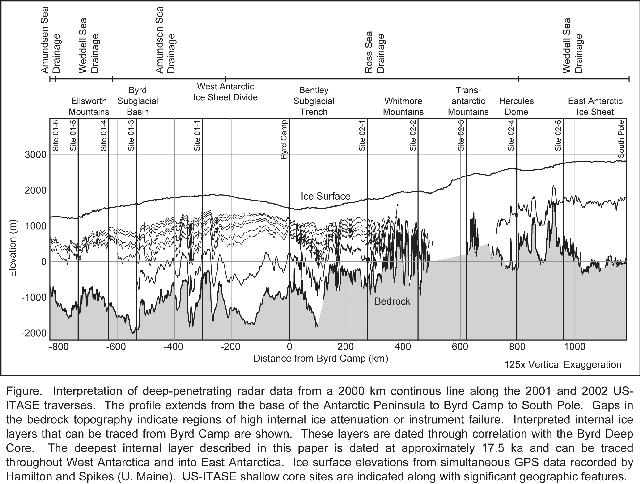A Time Marker from the LGM Detected Throughout West Antarctica
Robert W. Jacobel , Brian C. Welch and Logan M. Smith
Department of Physics, St. Olaf College
Northfield, MN 55057
Deep radar soundings as a part of the US-ITASE traverses in West Antarctica have revealed a bright internal reflector that we have imaged throughout widespread locations across the West Antarctic Ice Sheet and extending to South Pole Station. The layer is seen in traverses emanating from Byrd Station in 4 directions and has been traced continuously for 535 Km toward the Weddell Sea drainage, for 500 km toward South Pole, 150 Km toward the Executive Committee Range and 160 Km toward Kamb Ice Stream. The approximate area encompassed by continuous records of the layer is 250,000 square kilometers. In many locations echo strength from the layer rivals the bed echo in amplitude even though it generally lies at a depth greater than half the ice thickness. At Byrd station where the depth of the layer is 1260 meters, an age of ~17.5 KYBP has been assigned based on the Blunier and Brook (2001) chronology. Hammer et al. (1997) note that at this depth in the Byrd core they found a peak in acidity more than 20 times the amplitude of any other in the core.
The association of this widespread isochrone with a date from the Byrd core provides a useful time marker near the end of the LGM for much of the ice in West Antarctica and possibly beyond. While we find that the internal stratigraphy is disturbed as ice flows through the Bottleneck in the Transantarctic Mts., we have identified the bright layer in the stratigraphic section that continues to South Pole Station. Elsewhere there is evidence for what may be the same layer in the EPICA Dome C core where anomalous concentrations of acid have also been found at 17.5 KY (Wolff, pers. com.). It is also possible that the same layer is present in our radar records from Siple Dome where a bright reflector occurs at approximate the same age, though matching the chemical signature may be difficult. In any case, the area where this layer can be identified may prove to be several times larger than the estimate above.
Using the age from the Byrd Core, we apply a layer-tracing technique and a simple flow model to infer an approximate depth-time scale and estimate the average accumulation rate at two locations in the WAIS, one near the Ross Sea - Amundsen Sea divide and the other at Hercules Dome, both possible sites for future deep ice cores.

